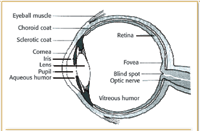The Baseline - Eyes: The Body's Own Spectroscopes
The author presents a discussion of the operation and optical complexities of the human eye.
If you stop and think about it, most people carry two personal spectroscopes with them at all times: their eyes.
Gray's Anatomy defines the eye as an "organ of special sense" (1), but otherwise does not define what the eye is. Simply put, the eyes are the sense organs that are sensitive to visible light. Most animal life is disproportionately dependent on the sense of sight for information gathering — no doubt taking advantage of the fact that most information is ultimately conveyed by light.
The human eye is a fascinating optical system. A general diagram of the human eye is shown in Figure 1. The optical power of the human eye, which is the reciprocal of the focal length of the optical system expressed in meters, is about 60 diopters (where a diopter = m-1, abbreviation D). That means that the focal length of an eye is 1/(60 m-1), or 0.017 m. That's 17 mm, which is — not coincidentally — about the size of an eyeball.

Figure 1. The bodys own spectroscope, the eye.
The Cornea
The optical power of the eye comes from two major components, the cornea and the crystalline lens (sometimes just called the lens). The cornea is a transparent, almost circular membrane. Its optical power is about 43 D, accounting for most of the optical power of the eye. It is a convex, uniform layer with a thickness of about 520-600 μm (0.52-0.6 mm) and a refractive index of about 1.38. Its radius of curvature varies with the individual, and also flattens with age. In addition to providing the majority of the optical power of the eye, it serves also as a barrier to dust, germs, and other foreign matter. The cornea actually consists of three layers: the epithelium, a five-cell-thick protective membrane; the stroma, a combination of water and protein fibers that comprises about 90% of the cornea, and whose structure provides the majority of the light-refracting power of the cornea; and the endothelium, a single-cell layer that serves to remove excess water from the stroma.
The Lens
The crystalline lens has an optical power of about 17 D. It is about 9-10 mm in diameter and about 4 mm at its thickest point. It is composed of thin layers, or laminae, and has a refractive index of about 1.40. Surrounding the lens is the ciliary muscle, whose chief function is to contract or relax and in so doing change the curvature of the front surface of the lens, allowing us to focus on near or far objects. In its most relaxed state, the lens is at its flattest, and the focus of the eye (ideally) is on infinity. To look at closer objects, the ciliary muscle contracts, the front surface of the lens curves more, and the focus of the eye gets closer. This is why looking at objects close up gets tiring after a while — it takes effort to hold the ciliary muscle in its tensed state.
Between the cornea and the lens is the aperture of the eye, the iris. The iris also is composed of layers, including a layer of involuntary muscle fibers that can contract and relax to regulate the amount of light that enters the eye through the pupil, the actual opening in the iris. The several layers of the iris also can contain a variety of pigment cells called melanocytes. For people with blue eyes, pigment cells are found in the inner layer of the iris only. For people with brown or black eyes, pigment cells also are found in the central and outer layers of the iris; the greater distribution of pigment cells absorbs more light, and the iris has a darker color. Also between the cornea and lens is a slightly alkaline saline solution called the aqueous humor. In an adult eye, the amount of aqueous humor in an eye is very small: less than 0.1 mL.
Inside the Lens
Behind the lens, making up about 80% of the entire eye, is the vitreous body, which is filled with fluid called the vitreous humor. Vitreous humor is completely transparent and contains some dissolved salts and a small amount of albumin, a protein. Its refractive index is about the same as water, 1.34. An average adult eye contains about 4 mL of vitreous humor.
At the back inner surface of the eye is the detector: the retina. The retina is a nervous membrane, about 0.5 mm thick, that is attached to the choroid, an inner structural membrane of the eye. Almost immediately opposite the pupil in the retina is the macula, which has a small depression called the fovea. It is here in the retina where vision is most acute. The retina is a fairly complex membrane consisting of 10 distinct layers. The most important layer from a detection standpoint is the next-to-innermost layer, called Jacob's membrane. Jacob's membrane contains the actual detector cells — more than 100,000,000 cells called rods and cones. There are 10 times as many rods as there are cones. Rods are small (~1 μm across) rod-shaped cells that are sensitive to the brightness of light. They need only one photon to function, and the actual chemical function of rod detection is caused by a chemical called rhodopsin (also called visual purple). Rhodopsin is a combination of a protein and 11-cis-retinal:

A photon is absorbed by 11-cis-retinal, which converts quickly to all-trans-retinal:

After a quick series of chemical steps, the rhodopsin is converted to a form called metarhodopsin II, which ultimately stimulates an electrical impulse that travels through the optic nerve to the brain for, shall we say, spectral interpretation. The compound 11-cis-retinal ultimately derives from vitamin A, which explains the connection between vitamin A deficiencies and vision problems. Rods are spread all over the retina.
The cones are conical-shaped cells about 10 μm across. Multiple photons are required to set off a detection response in cone cells. Cones are responsible for spatial acuity and color detection; in fact, there are three types of cones, each sensitive to different wavelengths of light. They go by various names, but here we will refer to them as red cones (560-565 nm wavelength maximum sensitivity), green cones (540-545 nm maximum sensitivity), and blue cones (440 nm maximum sensitivity). The actual chemical function of the cones is similar to that of the rods, except that the protein attached to the retinal moiety differs by several amino acids, making the protein-retinal complex sensitive to slightly different wavelengths of light. The brain perceives different colors by having the three different types of cones produce different amounts of signal. Cones are concentrated in the macula of the retina, which accounts for the eye's high acuity when focusing straight ahead.
The Optic Nerve
About 3 mm away from the macula is a bundle of nerve fibers called the optic nerve. The optic nerve transmits the electrical impulses from the retina directly to the brain; it has no additional physiological function (unlike the other major nerves of the nervous system). In the area where the optic nerve leaves the eye, there are no rods and cones, so this area of the retina does not detect light. Instead, there is a 1-2 mm-diameter "blind spot" in the retina. Some argue that the optic nerve is more like brain tissue than nerve tissue. One characteristic of optic nerve cells is that they are extremely sensitive to formic acid, one of the metabolites of methanol. This explains why people who accidentally drink methanol go blind — the cells in the optic nerve are killed preferentially to other nerve cells.
Although the eye can be considered a superb biological spectroscope, many eye ailments are caused by a mis- or malfunction of one or more optical components of the eye. Perhaps we will visit some of these in another column...
Reference
1. H. Gray,
Gray's Anatomy,
T. P. Pick, R. Howden, eds. (Bounty Books, New York, 1977).

David Ball
David Ball is a professor of Chemistry at Cleveland State University in Ohio. Many of his “Baseline” columns have been reprinted in book form by SPIE Press as The Basics of Spectroscopy, available through the SPIE Web Bookstore at www.spie.org. His new textbook, Physical Chemistry, was published in August 2002. He can be reached at the Department of Chemistry, Cleveland State University, Cleveland, OH 44115, by e-mail at d.ball@csuohio.edu, or by phone at (216) 687-2456. His personal website is academic.csuohio.edu/ball
